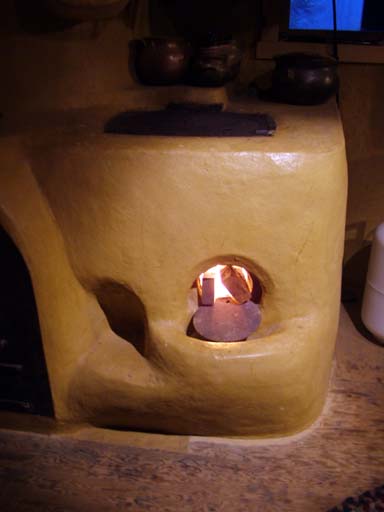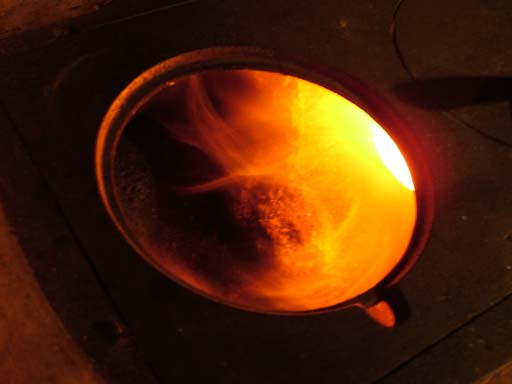johng
New Member

Posts: 10
|
Post by johng on Oct 11, 2009 13:36:40 GMT -8
Hi All --
A few quick questions for those with experience using rocket stoves (particularly attached to mass) for cooking...
I'd like to put together a rmh and a bread oven, and use it for cooking and heating my house. This seems to be an ideal combination for cold, northern winters, but I can't figure out the best way to cook during the summer. Obviously, you don't want to fire up the rmh during the summer, since you want to keep things cool. So, what would the best way be to cook indoors during the summer?
One possible solution would be to have a low/no mass rocket stove for summer cooking, but then what about ventilation? I like the coffee rocket stove shown in Ianto's book, but just am not sure whether that is a good solution indoors, even when you can have windows and doors open.
Another solution is to have an outdoor, open-air cooking area, with some type of low mass rocket stove and a cob oven (and a roof for all weather use...), but once again, this seems a little bit unpractical.
I also like the idea of lorena stoves and the 'estufa rocky,' but... ventilation for indoors use.
So, what are you guys doing?
Thanks for the input! Keep cobbin'
-john
|
|
|
|
Post by canyon on Oct 12, 2009 20:58:43 GMT -8
As a northern dweller I like the outdoor summer kitchen. It is such a pleasure to use. I think of it as very practical.  |
|
shane
New Member

Posts: 6
|
Post by shane on Oct 13, 2009 5:30:13 GMT -8
I'm currently looking at a similar challenge. One possible solution might be placing a 'Y' section just after leaving the stove that has a manual operable gate. That way exhaust could be steered to the mass heater or directly outside depending on the circumstance.
|
|
|
|
Post by Donkey on Oct 13, 2009 9:05:07 GMT -8
Here at my place, I made the cook top and the heater into separate stoves that share a chimney. The mass heater does it's business, and the cooker dumps its heat straight up the chimney and outside. I kinda like your Y idea. But best of all the outdoor kitchen! I'm gonna build one here as soon as the old mobile home that currently occupies the space is gone. Can't wait!! Ovens and cook tops and BBQ's and wok stoves, oh my!  |
|
johng
New Member

Posts: 10
|
Post by johng on Oct 13, 2009 11:30:01 GMT -8
Thanks for the thoughts. A 'Y' section could solve some of the issues. One concern I would have is that the final exhaust temp from cooking would be much higher than from mass heating, so the chimney needs to be able to handle higher temps than if you're just building a mass heater. Should be easy to take care of, but needs to be part of the initial design.
I also like the idea of a summer kitchen. As long as it has a roof, it should be usable in most warm season weather. And if you get a spell of cold, blustery summer weather (hey, it happens!), then just fire up the kitchen facilities in the house, and enjoy the extra warmth inside. Screening might be useful for the outside cookhouse to keep out flies, mosquitoes, and the like.
Donkey: a couple of questions about your stove top... iirc, your stove top has removable round sections (like an old wood cookstove, I assume). How well does that work with a rocket stove, since the exhaust system on a rocket is + pressure based rather than - pressure based like a traditional stove? Do you get hot gases coming through the small cracks between the plates? And when you cook on the stove, are you removing the plate and putting a pan directly on the flames, or are you cooking on the metal surface?
Thanks again, everyone.
-john
|
|
|
|
Post by Donkey on Oct 13, 2009 19:16:41 GMT -8
Donkey: a couple of questions about your stove top... iirc, your stove top has removable round sections (like an old wood cookstove, I assume). How well does that work with a rocket stove, since the exhaust system on a rocket is + pressure based rather than - pressure based like a traditional stove? Do you get hot gases coming through the small cracks between the plates? And when you cook on the stove, are you removing the plate and putting a pan directly on the flames, or are you cooking on the metal surface? -john Works fine. Sometimes when I'm just starting it, there is a tiny puff of smoke but it clears almost instantly. Really, since I'm just dumping the leftover heat right outside, there isn't any horizontal run to speak of (possibly as much a 2 feet) so the cook top is both + and - pressure.. The thing SCREAMS. I used an old cast iron potbelly stove top, so yeah, there are 2 removable plates. Once the stove is running, I can pop off a plate and watch the fire bend horizontally for a moment, under the (now open) plate, then zip to the back and out, across 2 ninety degree turns. Yep, I just pop off the plate(s) and stick pots and pans over the hole. Or I can toss tortillas right on the cook top. I cure it with oil, like a cast iron pot. The heat riser comes up directly under one plate and burns across the second before making it's turn to go out to the chimney. Depending on the heat that I want for any given use, I got options. |
|
|
|
Post by Donkey on Oct 14, 2009 7:23:44 GMT -8
To be completely honest.. This stove heats up the kitchen PLENTY. I just used it to make breakfast this morning (and took a couple pictures). IF this were the middle of July or August, I wouldn't want to be using it. So I'd say that part of the reason for designing it the way it is, is a failure.. Granted, it dumps much of it's heat outside, PDQ, but it definitely heats the kitchen more than I had planned. Images of it running this morning: Pretty much all Aprovecho in concept..  First plate (right one) off. Notice how the flame is being drawn left (towards the second plate).  Second Plate (left one) off. You can see the flames change direction, drawn to the back and out.  |
|
johng
New Member

Posts: 10
|
Post by johng on Oct 14, 2009 10:44:53 GMT -8
Thanks for the specifics, and the great pics! They definitely help to show what is actually happening inside your stove.
Now I need to think about ways to modify it so that it could be used indoors in July. Perhaps more insulation in select areas, or something along those lines? Hmmm. ..
-john
|
|
|
|
Post by yesimag on Nov 23, 2009 13:08:09 GMT -8
I think ventilation will be a big factor in your success too. Unless you can get some serious cfm's moving through your living space, any amount of insulation on the stove isn't going to help. You've got to exchange that air. Of course if you live where I do, half the time it's 100 degrees plus so that doesn't help beyond passing a breeze over your sweaty skin.
|
|
hpmer
Full Member
  
Posts: 240
|
Post by hpmer on Nov 26, 2009 17:07:48 GMT -8
|
|
johng
New Member

Posts: 10
|
Post by johng on Dec 3, 2009 18:16:24 GMT -8
That looks like a great site -- I'll have to check it out later when I have a little more time! Thanks.
|
|
|
|
Post by rockitman on Nov 29, 2015 9:44:47 GMT -8
Bump! Would love to hear about folks' set-ups and solutions for indoor rocket cooking in the summer. Any developments and inventions?
|
|
lawry
Junior Member
 
Posts: 113 
|
Post by lawry on Jan 22, 2016 0:03:21 GMT -8
Hi I m still design as I go. I have added a bypass immediately after the cooktop chamber where the flue gas can go left to the chimney or right to the oven. With the bypass open the oven (thermal mass) doesn't get hot, but chimney gets very hot. So in summer using the oven would be a warm experience...  The bypass helps with initial lighting too. |
|
|
|
Post by vimes1984 on Aug 23, 2017 4:19:19 GMT -8
Hey there,
I'm really interested in this do you have any plans? Or can you recommend any books I can buy?
Chris
|
|